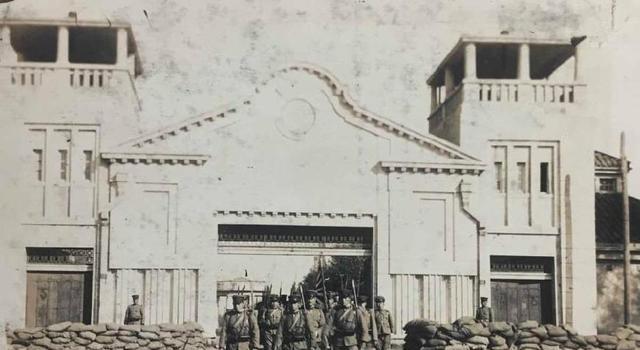Far East "Krupp"
Zhang Zuolin (March 19, 1875 – June 4, 1928), courtesy name Yuting, nicknamed Zhang Laojie, was a native of Beixiaowa Village, Haicheng County, Liaoning Province, who was born into extreme poverty and spent three months in private school, slightly literate. Under the promotion of Zhao Erxun, the governor of the three eastern provinces, he later became the leader of the Beiyang Army, and liked to be called "Zhang Dashuai".
In 1921, Zhang Zuolin ordered the construction of a factory for repairing and manufacturing firearms in the Mint of Dadong District of Shenyang, named Fengtian Ordnance Factory.
In April 1922, after the defeat of the Zhifeng War, Zhang Zuolin hung the four big characters of "Don't Forget My Shame" in the lobby. He also vigorously promoted education and straightened out the Fengjun. That kind of fierceness caught many people off guard; that kind of blood cost, let the people around them stunned.
In 1922, Northeastern University was established; in April 1923, Northeastern University was established, becoming the largest and most funded university in China at that time, with an annual funding equivalent to more than three times that of peking university, which ranked second. Zhang Shizhao, Huang Kan, Liang Sicheng and other famous scholars have all come here to teach.
At the same time, Zhang Zuolin renamed the Fengtian Ordnance Factory to the Eastern Three Provinces Arsenal. Outside the big east gate, the factory was re-established, and on the west side of the factory, the platform was built, and the railway was laid, and the train could be directly connected to the factory. Steelmaking plants, machine factories, boiler rooms, water towers, waterways and other equipment have been added successively, and military primary schools and military engineering schools have been set up.

The total investment of the arsenal in the three eastern provinces exceeded 500 million yuan, and the expansion was completed in 1928. It was the first arsenal in Asia at that time, and was known as the "Krupp of the Far East". This factory is really a bloody cost, you know, in 1928, the central financial revenue of the National Government was only 179 million yuan.
The equipment of the factory is mostly collected from Krupp, Germany, with a total of more than 8,000 sets, and all kinds of machinery and equipment and precision instruments are readily available, many of which are not even available in Japan at that time. There are 1,516 military technicians from all over the world, many of whom Zhang Zuolin recruited from more than a dozen countries such as Britain, France, the Soviet Union, the United States, Germany, and Sweden at high salaries.
Zhang Xueliang changed to a furniture factory
In 1930, after the Great War of the Central Plains, Zhang Xueliang vigorously called for peace and called for soldiers, hoping that everyone would live in peace, not invade each other, and value peace. In addition, a large number of military technicians and workers were reduced in the arsenal, and they were converted into civilian factories to produce civilian materials, mainly furniture. At that time, the Dongshengyuan Sales Office was set up in Shenyang Daxiguan, and there was a sample catalog display for candidates to purchase.
Expansion in Japan
After the September 18 Incident, the Northeast Army withdrew from the Northeast without firing a single shot, and the Japanese army occupied Shenyang, changing the Arsenal of the Three Eastern Provinces to the Field Weapons Factory of the Kwantung Army, which was later changed to the Fengtian Arsenal Co., Ltd., with Lieutenant General Kurosaki Iwajiro as the president.
In 1937, it was expanded into eight classes and six manufacturing centers, the whole factory has more than 10,000 machines, and the anti-aircraft gun factory has been added, with more than 1,200 technical management personnel and more than 30,000 workers, of which the Japanese account for about one-tenth of the total number of people in the factory. At that time, 45% of the Japanese weapons and equipment in the Chinese battlefield were rifles and mountain guns, 70% of the ammunition was provided by the factory, and the mortars and grenadiers were all from the factory.
The Soviets evacuated
On August 6, 1945, the United States dropped an atomic bomb on Hiroshima, Japan. In order to enter the northeast before Japan surrendered, the Soviet Union declared war on Japan on August 8. On August 9, the Soviet Union, in a very hasty situation, ordered more than 1.5 million Red Army troops into northeast China. On August 15, the Emperor of Japan announced his acceptance of the Potsdam Proclamation and his unconditional surrender. On 19 August, all the Eastern Armies surrendered their arms to the Soviets.
In the six months from the occupation of the northeast to the withdrawal of troops in February 1946, the Soviet army carried out the important industrial equipment and materials of the three eastern provinces, which were then the largest industrial center in Asia.
The arsenal was not spared, and two thousand four hundred of the finest machines were shipped back to the Soviet Union. The equipment that could not be taken away was destroyed.
Aftersound
After the collapse of the Soviet Union, according to an old employee retired from the former Soviet state-owned enterprise , the "Salyut" company, there was a mysterious factory building in the company, with a long-term locked gate and guards standing guard to prevent ordinary people from approaching. It wasn't until the late 1970s, 20 years after he entered the factory, when he was about to process a precision part for a new military gas turbine engine, that the factory leaders took him into the mysterious factory building. After going in, I found that it was all some machine tools and other equipment that had been shipped back from northeast China.
At that time, he lamented that the Soviet Union in the 1970s had to rely on these equipment shipped back from northeast China in the 1940s to process the most sophisticated parts.